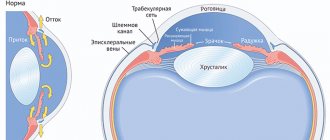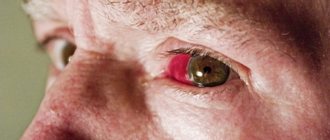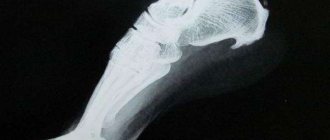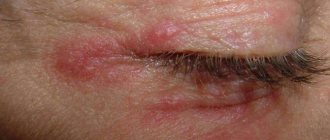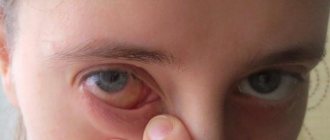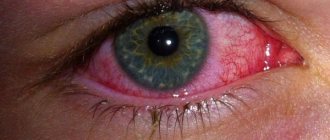Symptoms
The symptoms that arise from an injury to the eyelid depend on the characteristics of its occurrence. If it is a bruise, the victim complains of severe pain and discomfort. Swelling develops, hematomas and bruises appear. When the top layer of the eyeball is damaged, bruises are visible on its surface.
In especially severe cases, such injuries affect the lens and cause retinal detachment.
When the eyelid is bruised, the reaction of the pupils to light often changes; they unnaturally increase in diameter. When exposed to light rays, the victim feels pain in the eyes, lacrimation is observed, and visual acuity decreases.
Very often, when the eyelid is injured, damage to the cornea occurs. In this case, the victim complains of the following symptoms:
- loss of clarity of vision;
- pain and discomfort when exposed to any light sources;
- “feeling of sand” in the eyes;
- swelling and redness of the eyelids.
Species and types
Eyelid injuries are usually classified based on their causes. On this basis, several varieties are distinguished:
- Contusion. Diagnosed after a blow with a blunt object. It is always accompanied by bruising of soft tissues, which leads to the appearance of a bruise under the eye. In severe cases, the conjunctiva ruptures and damage to the lacrimal canals occurs.
- Erosion. Characterized by the appearance of scratches or abrasions. Such injuries are always accompanied by bleeding, pain, and swelling of the tissues. If there is no damage to the eyeball, there is no need to see a doctor. Often, only a light antiseptic treatment of the skin is sufficient.
- Wound (puncture, cut, laceration). It can be superficial and through. This variety is very dangerous and requires qualified medical intervention .
Classification by type of traumatic factor
Injury to the eyelid can occur not only when exposed to mechanical factors. Damage to the eye area can occur for other reasons, according to which classification is carried out.
- Thermal burns. Occur due to skin contact with hot liquids, hot objects, or open fire.
- Chemical burns. Occurs when aggressive chemicals - acids, alkalis - come into contact with the surface of the eyelid.
- Frostbite. Observed when the skin is exposed to extremely low temperatures.
- Burns from ultraviolet radiation. Most often occur during prolonged exposure to the sun or due to non-compliance with the rules for performing medical procedures where quartz lamps or other light sources are used.
Themis with sewn eyes
In world judicial practice, the goddess of Justice Themis is usually depicted blindfolded. But few people know the true meaning of this image.
Like any Greek deity, the Goddess of Justice had her own double in the Roman pantheon. She turned out to be the great Justice - the Roman goddess of Justice. The modern figurine symbolizing a fair trial is more likely Justice than Themis. This judgment is confirmed by an additional attribute - a blindfold, which symbolizes equality and impartiality. Themis among the Greeks held court with her eyes open. This is how a curious incident arose: in the modern world, the goddess of Justice is called Themis, but is depicted as Justice.
But it seems that in the Russian judicial system, in general, all these subtleties have been completely erased. Because the current Russian Court seems to have nothing in common with either Themis or Justice. And the eyes of the poor fellow depicted on our domestic judicial attributes are most likely not blindfolded, but sewn shut!
Yes Yes! Exactly sewn up! Moreover, they are sewn with the very “white threads” with which our investigative and prosecutorial workers “sew” the criminal cases of some accused, who are transported in closed prison vans to hearings, as the hero of one very famous Soviet film comedy said, “the most humane and fair court in the world”!
At the same time, in accordance with ancient Greek mythology, it was assumed that judges served as servants of that same Themis.
Taking into account amendments to ancient Roman history, they should also be servants of the goddess of Justice - Justice.
But, apparently, in the Russian Justice system everything is built on completely different principles. And we can only guess whose servants our dear Russian judges are. Themis? Justice? Or some aunt dressed like Themis, but with a blindfold like Justice, which is tightly sewn to her forehead with white threads of a false investigation and secured with a stapler from the prosecutor's office? So that, God forbid, at least one ray of Truth does not peek through from under this bandage!
In such a situation, the scales that the Russian Themis-Justice holds in its left hand are, in principle, useless. Because you can put anything on them. Even a piece of dried crap! A goddess with her eyes sewn shut from pain shock will not even feel the fetid smell of this very shit! And she will only dream of being released to rest as soon as possible. Because our valiant “law enforcement officers” have learned to use even the night time for their “business sewing”.
In this regard, some servants of our native Russian Themis-Justice, upon closer examination, look very unsightly. They communicate with the participants in the “trial” tiredly and very irritably. It’s as if they themselves are serving hard labor. They try to complete any “business” as quickly as possible, without even delving into the essence of the issue. And without even understanding that behind each of these so-called “cases” there are specific people, specific destinies, specific life situations.
These “servants” of Themis-Justice sometimes look very tired. It was as if they themselves had been beaten with sticks for a long time and tortured with the most cruel tortures. They look at the world sadly, through the prism of their greasy glasses, which they are even embarrassed to wipe from time to time. In order to at least superficially and elementary imagine what they will make a decision about.
The servants of Themis-Justice listen to the arguments of the defense of the suspects and accused with extreme irritation. And sometimes they don’t even give you the opportunity to speak out. But, with a certain spellbound delight, they perceive any nonsense that comes from the mouth of the next investigative “tailor” or - His Excellency Mr. Prosecutor.
A huge number of examples of such behavior of our unfortunate servants of Themis-Justice could be cited. But, I will focus on just one thing.
On July 18, 2020, the judge of the Appeals Board of the Moscow City Court, S.V. Andreeva, considered the “case” of the illegal arrest of a graduate of Moscow State University. Lomonosov, a graduate student of this leading Russian university, Dmitry Bogatov.
From Dmitry Bogatov’s IP address on the Internet, someone under the name “Ayrat Basharov” distributed a certain note (as investigators admitted) of “extremist content.” Deciding that this was done by the graduate and postgraduate student of Moscow State University. Lomonosov, investigators decided to detain him and take him into custody. And the court, having heeded certain “arguments” of the investigation, without doubting anything, gave sanction for the arrest of this young man and his detention.
At one point, a successful graduate and postgraduate student of the most advanced Russian university turned into an “extremist” and “terrorist”. Just on the basis of some “note” on the Internet. In which, by the way, almost two dozen grammatical and spelling errors were made on one sheet. Which, you understand, does not fit in with the status of a “Moscow State University graduate.”
It is quite clear that investigators and prosecutors had to report on the “work done” in the “fight against extremism.” And they, as usual, “sewed the whole thing with white thread.”
Apparently, according to the old proven method, they left some of these “white threads” for the servants of Themis-Justice. In order to, as it should be done in such cases, “sew up” their eyes when making decisions.
And representatives of the suspect’s defense always act as an additional irritating factor in such cases. And this usually makes the “servants” very upset. They begin to get nervous, fuss, and stamp their feet. And make serious mistakes.
Apparently, they forgot about another very characteristic symbol, which is in the right hand of the goddess Themis-Justice - the sword!
And he is not at all simple! It's double-edged!
This means that one of its blades is directed towards the criminal, and the other towards the one who is judging him!
And one day a situation may arise in which the second blade suddenly starts working actively. And the blindfold will be tightly sewn on! Those same “white threads” of a false investigation and biased “prosecutor’s supervision”!
I think that the outcome in such a situation is clear even to a complete idiot!
So, maybe, before it’s too late, our servants of the goddess Themis-Justice can have a little cosmetic surgery? To save them later from more severe consequences?
Better yet, let them take off all the blindfolds from their eyes and honestly look into the eyes of those whom they are trying to send to jail on the basis of “fictitious cases” concocted by our home-grown Pinkertons!
The author is a member of the Moscow Writers Union
Consequences
With minor injuries to the surface of the eyelid, deep damage usually does not occur, which poses a potential danger to humans. But in many cases they are quite painful, accompanied by swelling and other cosmetic defects.
The bruise that appears at the site of the injury completely disappears only after two weeks.
In the absence of adequate treatment or with deeper injury, the following complications may develop:
- Infection of surrounding tissues. The penetration of a bacterial infection into the human body can lead to the development of serious diseases - purulent sinusitis, conjunctivitis.
- When muscle structures are involved in the pathological process, adhesions occur. This leads to the fact that a person cannot close his eyes normally. To correct such a defect, surgery is required.
- When infection enters the wound, there is a possibility of scarring. This is not only aesthetically unattractive, but can also disrupt the process of closing the eyes.
- If organ structures are damaged, complete or partial loss of vision is possible.
Symptoms of the disease
How can you recognize such a dangerous pathology in yourself? The disease is dangerous because the symptoms of a retinal tear do not always appear. Minor damage may not manifest itself in any way, so people do not even suspect that they have problems with the mesh tissue. Long-term lack of treatment leads to complications: retinal detachment begins to develop.
For large ruptures, a clear clinical picture is observed, including the following symptoms:
- A sharp decrease in vision, the cause of which is unknown;
- Vague perception of surrounding reality;
- Fields of vision are significantly narrowed;
- With the slightest physical exertion, spots begin to flash before the eyes;
- Unexpected bright flashes of light appear in dark rooms;
- Some areas of space become invisible to the eye;
- Visible objects seem to be covered with a veil.
Intensification of symptoms most often occurs gradually. The exception is the rapid progression of pathology associated with macular hole. The appearance of a constant veil before the eyes and limitation of the field of visual perception is extremely dangerous. These signs indicate that the mesh tissue has begun to delaminate. Such disorders can cause complete blindness, which can only be stopped by surgical intervention.
At the same time, during a night's rest, the symptoms practically disappear, as the location of the retina changes: it straightens and completely joins the eye. However, 2 to 3 hours after the visual organs begin their full work, the signs will return.
Diagnostic tests
Considering that in the initial stages of development of the pathology, symptoms appear weakly, disorders can only be detected in an ophthalmologist’s office with the help of specialized equipment. The following methods are used to diagnose the disease:
- Visiometry – assesses the extent to which visual acuity has decreased;
- Tonometry – determines indicators of intraocular pressure, the increase of which is associated with the accumulation of fluid or blood;
- Ophthalmoscopy – assessment of the condition of the fundus;
- Biomicroscopy – examination of the eyes using a slit lamp;
- Ultrasound of the eyeball.
If pathological changes are caused by vascular diseases, fluorescein angiography is performed.
Diagnostic measures allow the ophthalmologist to determine the number of ruptures that have occurred, their location and the duration of the pathological process. The prescribed treatment will depend on the identified indicators.
First aid
After receiving an injury, it is necessary to provide the victim with first aid:
- If there are open wounds, it is advisable to apply a sterile bandage to the problem area . In case of deep tissue injury, it is recommended to carry out the same manipulations with the healthy eye. This will prevent them from moving in sync.
- If you receive a contusion, apply a cold compress to the problem area. To do this, use ordinary water, ice, and metal objects.
- In case of deep injury to the eyelid, it is not recommended to independently engage in antiseptic treatment of the skin. To do this, it is best to consult a doctor who can correctly assess the extent of tissue damage.
- If a serious injury to the eyelid occurs involving the eyeball in the pathological process, measures are taken to stop the bleeding. You should not try to remove foreign objects yourself, as this can lead to even more serious consequences. It is best to cover the area of injury with a sterile cloth and seek medical attention.
- If you receive a chemical burn, you should rinse your eye thoroughly with running water to remove particles of aggressive substances. After this, a sterile bandage is applied to the problem area.
If a child has suffered an eyelid injury, it is recommended to contact a pediatric ophthalmologist as soon as possible and not take any action on your own.
Eye injury
Complex penetrating wounds of the cornea and sclera occur in approximately 80% of cases. They are almost always accompanied by more or less pronounced impairment of visual functions. In the wound channel, the internal structures of the eye are often infringed. The choroid (iris, ciliary body, choroid), as well as the retina and vitreous body, and occasionally the lens, often fall into the wound. However, with small wounds (puncture wounds), the internal structures of the eye do not fall out into the wound, retain their previous location, but are damaged. Most often (in 20% of patients), with penetrating wounds of the cornea, the lens is damaged and cataracts occur, and with wounds of the sclera, almost all the internal membranes and structures of the eyeball can be damaged. Damage to the internal contents of the eye may not be detected immediately, but after several days, for example, when hemorrhages resolve.
The presence of foreign bodies can often be determined using biomicroscopy and ophthalmoscopy. However, when foreign bodies are introduced into the area of the angle of the anterior chamber and the ciliary body, as well as in the presence of hemophthalmos, they can only be detected with gonio- and cycloscopy, as well as echography and radiography.
First aid for eye injuries
- Rinse the eye with antiseptic solutions and instill antibiotics. Solutions of furacillin and rivanol are suitable for washing. For instillation, any antibacterial agents: albucid, gentamicin, chloramphenicol, cipropharm, tobradex, vigamox, etc.
- Pain relief . Solutions of novocaine (lidocaine) are suitable for this, which can be dripped from a syringe without a needle. You can take analgin or any other painkiller intramuscularly.
- Apply a clean bandage (preferably a sterile bandage).
- Urgently consult an ophthalmologist.
Treatment
A survey X-ray of the orbit is carried out in two projections to exclude a foreign body inside the eye, and then surgical treatment of a penetrating wound of the eye, which consists of gentle excision of the membranes that have fallen into the wound.
In modern conditions, wound treatment is carried out using microsurgical techniques. During the surgical intervention, foreign bodies are removed and damaged structures are reconstructed (removal of the lens, excision of a vitreous hernia, suturing the damaged iris and ciliary body, etc.). Frequent (every 1 mm) sutures are placed on the wound of the cornea and sclera to completely seal it. Antibiotics, corticosteroids and other drugs are administered parabulbarically, and a binocular aseptic dressing is applied. Dressings are done daily. In the postoperative period, active general antimicrobial and local (every hour during the day) anesthetic, antibacterial, anti-inflammatory, hemostatic, regenerative, neurotrophic, detoxification, desensitizing treatment are carried out. From the 3rd day, resorption therapy is prescribed (lidase, trypsin, pyrogenal, autohemotherapy, oxygen, ultrasound, etc.).
If an intraocular foreign body is detected on radiographs, it is necessary to localize it using the Komberg-Baltin method. Removal of metal magnetic fragments from the eye must be carried out in all cases in the early stages; the phenomena of iridocyclitis complicate the removal of fragments at a later stage and increase the likelihood of postoperative complications. Magnetic debris is removed using a magnet.
Therapy
You can begin home treatment for such injuries (even minor scratches) only after consulting an ophthalmologist. It is necessary for a specialist to examine the victim and determine the extent of tissue damage. Very often, when the lower eyelid is injured, the tear ducts rupture, which does not appear outwardly. This requires mandatory medical intervention.
Typically, treatment of such injuries is carried out according to the following algorithm:
- If you receive a bruise on the first day, it is recommended to apply cold to the problem area . Only after this can you apply warm compresses, which will speed up healing by increasing blood flow.
- When diagnosing erosion, antiseptic treatment of damaged areas is recommended. If deep layers of tissue are injured, it is advisable to entrust this process to an ophthalmologist.
- Cut and lacerated wounds require suturing followed by antiseptic treatment of the damaged area.
- For serious injuries, the use of drugs such as calcium dobesilate, Ascorutin, Etamzilate is indicated. These medications reduce the risk of complications and speed up the onset of recovery.
- If the tear ducts are damaged, surgical intervention is performed to restore their patency.
- If the cornea of the eye is affected, the use of special drops that produce a restorative effect is indicated. The most popular drugs from this group are Korneregel, Vitasik, Solcoseryl, Hyphen.
- With the development of severe pain, drops are used - Lidocaine, Alcaine.
- In case of superficial injury to the eyelid, it is permissible to use folk remedies. You can use infusions of medicinal herbs - calendula, chamomile. Pour 235 ml of boiling water over a tablespoon of plant material and wait until the liquid cools. After this, the infusion is filtered and applied as a compress.
Treatment of injuries localized on the surface of the eyelids requires a professional approach. Only by following all the doctor’s recommendations will it be possible to achieve a positive result and avoid the development of complications.

